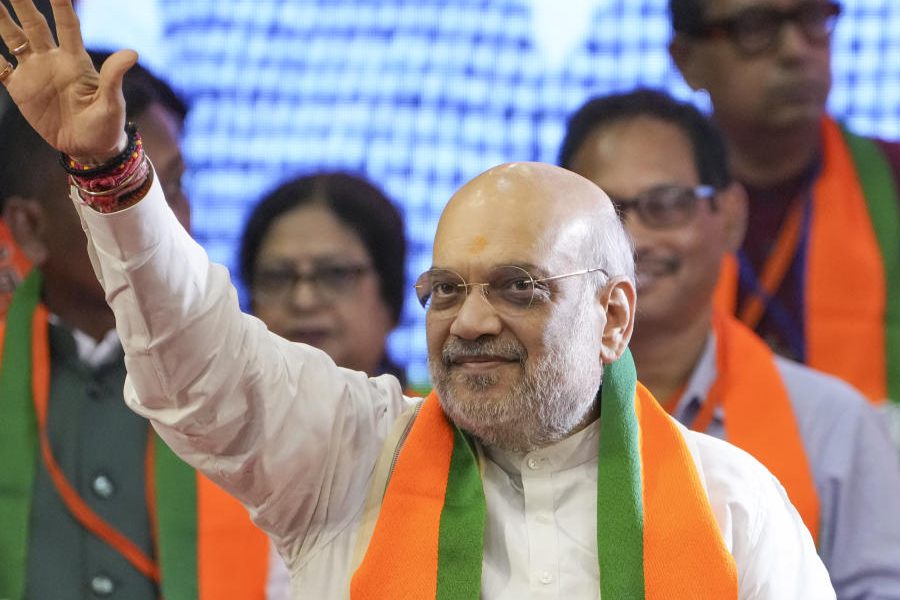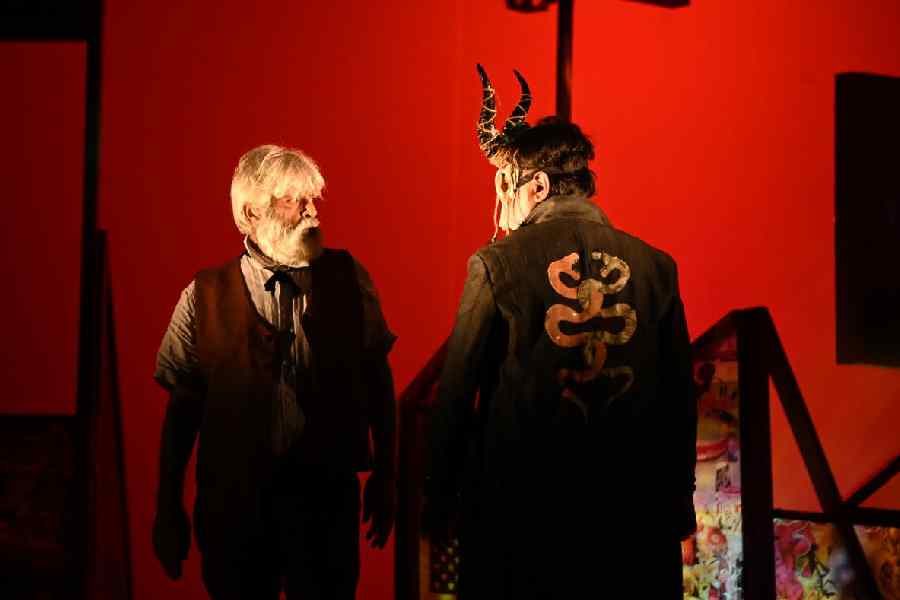 |
| Students and others in Saturday’s rally to protest the police action at Jadavpur University. Picture by Amit Datta |
The war cry “Hok kolorob (let there be noise)” has not only ignited a groundswell of protest but also tickled back to life Bengal’s dying tradition of nuanced humour and acerbic wit.
Calcuttans, no stranger to traffic-choker rallies that make life difficult for everyone, might well be sold on the slogans that have made the agitation led by students of Jadavpur University so different from the rest.
Bengal, of course, owes a debt of gratitude to the other Bengal for the leitmotif of the protest. “#Hokkolorob”, the hashtag that has become a social media sensation over the past week, is borrowed from a song by the Bangladeshi singer-songwriter Arnob.
If the lyrics of Arnob’s anthem challenges conventional thinking — Hok kolorob phool gulo shob nil na hoye lal holo ken/Oshombhobe kokhon kobe megher sathe mil holo ken — the sloganeering that shouldered a procession of thousands through the heart of Calcutta on Saturday was hard to ignore for rhyme and reason.
Sample: “Ei VC ke tule ne/OLX-e bechey de (Pick up this VC and sell him on OLX).”
Intelligent humour had all but disappeared from Bengal’s student politics. “The kind of slogans and banners heard and seen at the rally on Saturday used to be the staple of the Sixties and Seventies. Then they went missing,” said a teacher who didn’t wish to be named.
“Students are always more ingenious than others and when students of a premier university are in the forefront, ingenious slogans will be thrown up… After the ’80s there were very few cases of such outpouring from students. So such slogans were also missing,” said veteran academician Pabitra Sarkar.
The word bohiragoto (outsider) on caps and T-shirts worn by some of the non-JU protesters was a wry reference to the police’s claim that “outsiders” had instigated trouble on the Jadavpur campus. Indrajeet Sengupta, a third-year student of history at Presidency, is credited with the idea of turning bohiragoto into the theme of a campaign that was no longer JU’s alone.
“While coining a slogan, we always try to rhyme it. We often borrow from a famous poem or song but it has to be in context. The poems and songs must be well known so that people can instantly relate to and relish chanting them,” said a JU student.
No one quite knows how “hok kolorob” caught on. “During the sit-in demonstration outside Aurobindo Bhavan from September 10, we organised a programme of theatre and songs and named it Hok Kolorob. We drew the name from Arnob’s song,” said Uddalak Bhattacharya, an MPhil student of comparative literature at JU. Social networking websites did the rest.
Every college or university has a few bright sparks who play copywriters whenever a slogan or a catchy legend is required. Meatier the cause, more the punch. “The most important thing is that it must sound good so that people get a high when saying it,” said one.
Some blame the stagnancy in sloganeering on the compulsion of mainstream political parties to reach out to more people, making slogan writers rely on the banal.
“Mainstream political parties and their student wings may have such compulsions but a movement like the one triggered by the incident at JU doesn’t. They can well keep their slogans witty and nuanced,” said Deb Roy, scriptwriter of Bhooter Bhabishyot and Ashchorjyo Prodeep, two films known for their witty lines.
No wonder Saturday’s rally could shout out loud against the CPM and Trinamul alike: “Alimuddin shukiye kath, shatru ekhon Kalighat (Alimuddin is a shrivelled stick, the new enemy is Kalighat).”
Not just words, even pictures speak. An image being shared on social media shows JU as part of comic book hero Asterix’s village in a replica of the original map depicting the Roman conquest (referred to as Maa, Maati, Maanush). It highlights “one small village of indomitable Gauls” (labelled JU), surrounded by the four Roman strongholds Compendium (Sankudeber Astana), Laudanum (Jadavpur Thana), Totorum (Laalbazar) and Aquarium (Nabanna).
Obelix might well have gone: “Tap, tap... these Calcuttans are crazy!”
THANK YOU, STUDENTS...
We spoke to a cross-section of non-students on Sunday, some who had marched on Saturday and some who wished they had. Metro mirrors their mood.
- Thank You Students, for displaying the rarest commodity in Bengal today: spine.
- Thank You Students, for restoring our sense of dignity.
- Thank You Students, for resurrecting the power of apolitical protest.
- Thank You Students, for reminding us what our city is capable of.
- Thank You Students, for reviving our faith in democracy.
- Thank You Students, for showing us adults how to do it.
- Thank You Students, your walk will help us find our feet.
- Thank You Students, your slogans will give us back our voice.
- Thank You Students, your unity will inspire us.
- Thank You Students, your outpouring will keep us afloat.
- “Aye shokole dekhe ja, chhatra-chhatri’r khomota (Come everyone and see the power of students)”
THE ANTHEM
 |
Hok Kolorob (Arnob)
Bangladeshi singer Sayan Chowdhury ‘Arnob’ is a rage on Calcutta campuses. Hok Kolorob was his solo album in 2006. The title track was composed between 1995 and 1998 when Arnob was in Kala Bhavana, Santiniketan.
The song that has gained an anthem-like status among youngsters talks about being different and being unapologetic about it.
 |
Hok Kolorob (Rupam)
Calcutta rock star Rupam Islam wrote, composed and recorded Hok Kolorob — to show solidarity with the students’ movement — on Sunday morning and posted the song on SoundCloud around 2pm. Two lines from the English version....
Leave the throne O King,
If you wrong the people
Kolorob hok –
Raise the noise











